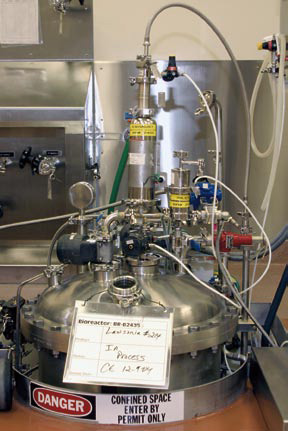7.1 What are the product characteristics of Enterisol® Ileitis?
The only vaccine available for active immunization against Lawsonia intracellularis is Enterisol® Ileitis from Boehringer Ingelheim.
This vaccine is based on an isolate of Lawsonia intracellularis which was obtained by routine methods from the ileum of a Danish pig in 1997. The pig was confirmed to have suffered acute hemorrhagic proliferative enteropathy by routine pathology. The isolate was attenuated by in-vitro passages in McCoy mouse fibroblast cell lines. Portions of each batch of the commercial vaccine (Enterisol® Ileitis vaccine) are rigorously cultured at two laboratory sites by routine cell culture and bacteriologic methods for adventitious viruses and bacteria, to ensure correct sterility apart from the intended Lawsonia intracellularis vaccine isolate.
The vaccine specifications are:
- Enterisol® Ileitis is a lyophilised vaccine containing live Lawsonia intracellularis bacteria which is reconstituted with a diluent into an oral suspension.
- This oral suspension needs to be administered to the target animals within a four hour time frame after reconstitution.
- The vaccine is designed to stimulate the development of an active immune response to Lawsonia intracellularis. Whereas, seroconversion following vaccination cannot usually be detected, and is not related to protection.
- The target species are pigs from three weeks of age.
- The indications for use are to induce active immunisation of pigs from three weeks of age and older to reduce intestinal lesions caused by Lawsonia intracellularis infection and to reduce growth variability and loss of weight gain associated with the disease.
- Under field conditions, the difference in average daily weight gain was seen to be up to 30 g/day when vaccinated pigs were compared to unvaccinated pigs.
- The onset of protection occurs as early as three weeks post vaccination and lasts for at least 17 weeks.
- There are no known contra-indications or undesirable effects.
- Since the vaccine isolate is a live bacterium, simultaneous use of antimicrobials which are effective against Lawsonia spp. should be avoided for a minimum of three days before and after vaccination.
- All materials used in administering the vaccine must be free of antimicrobials detergent or disinfectant residues to prevent inactivation.
- It is recommended to add skimmed milk or sodium thiosulphate solution as a stabilizer into the drinking water prior to adding the vaccine. The final concentration of the skimmed milk should be 30 ml/litre. The final concentration of sodium thiosulphate should be approximately 0.055 g/litre.
- No adverse reactions have been observed following administration of ten times the recommended dose.
- The vaccine is an attenuated live vaccine and the potential for spreading to non vaccinated animals cannot be excluded. However, based on the studies conducted with sentinel pigs, the apparent frequency of spreading and associated risk is very low. Lawsonia intracellularis DNA could be detected up to three days post vaccination in faecal samples of more than half of vaccinated animals, therefore transmission to pen-mates can not be excluded in this time period.
- The withdrawal period is zero days.

Picture 7.1 a
Production facility of Boehringer Ingelheim
in St. Joseph, Missouri, USA.
A general advantage of an attenuated live vaccine approach is that the efficacy and duration of immunity are usually relatively good compared to other vaccine approaches, as the host’s immune system is exposed to all the antigenic properties of the organism in a more “natural” manner. Specifically for intracellular bacterial agents such as Lawsonia intracellularis, the live attenuated vaccine approach offers the best available protection for vaccinated animals, due to a full and appropriate T cell based immune response. This contrasts to the variable to poor immunity associated with subunit or killed vaccine types for intracellular bacteria. This is also specifically true for obligate intracellular bacteria such as the Chlamydia sp, which cause pathogenic infections within a mucosa. These studies indicate that whole live attenuated forms of the intracellular bacteria in question are:
* Best delivered to the target mucosa.
* Required as whole live bacterial forms to produce a fully protective immune response in the target mucosa.
* Immunologicaly superior compared to use of partial bacterial components as vaccines (the subunit approach), which allow “holes” in the immune response.

Picture 7.1 b
Fermentation-vessel in use for production of Enterisol® Ileitis.
© Boehringer Ingelheim Animal Health GmbH, 2006
All rights reserved. No part of this Technical Manual 3.0 may be reproduced or transmitted in any form or by any means, electronic or photocopy, without permission in writing from Boehringer Ingelheim Animal Health GmbH.






